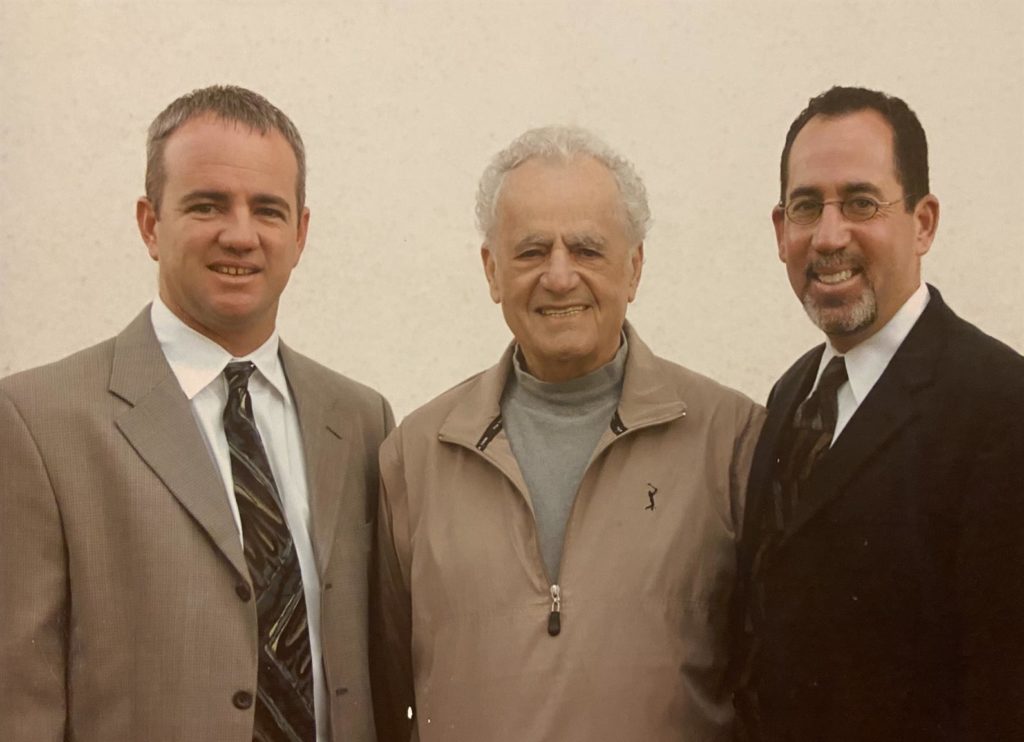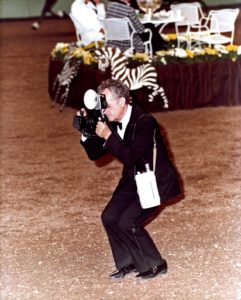Ashley Swift of US Equestrian takes you behind the scenes with a conversation with the Schatzberg family. They have been shooting horse shows for three generations! Words by Ashley Swift.
Photography is more popular than ever, with numerous photo sharing and editing apps just a tap away on our phones. But for photographer Howie Schatzberg and his nephew, fellow photographer Casey McBride, professional horse show photography is a family tradition.
Howie and Casey grew up in the business learning from the late Jack Schatzberg, Howie’s father and Casey’s grandfather. Jack got his start in photography in New York taking photos of babies, but it was his daughters, Sue and Terry, who got him started in the horse industry.
“We moved to Chicago and my sister Sue started showing American Saddlebreds. My dad would take pictures of her, and then another mom or dad asked him to take a photo of their daughter,” said Howie. “We moved to Arizona and my sister Terry, Casey’s mother, started showing Arabian horses, so my dad took photos of her. And the same sort of process got rolling again.”
 Three generations of Schatzberg family photographers. Left to right: Casey McBride, Jack Schatzberg, and Howie Schatzberg. Photo courtesy Schatzberg family.
Three generations of Schatzberg family photographers. Left to right: Casey McBride, Jack Schatzberg, and Howie Schatzberg. Photo courtesy Schatzberg family.
According to Howie, Jack was an entrepreneurial man and saw the opportunity to make a living in equine photography. “He realized that people wanted these photos. They wanted nice pictures of their horses,” said Howie.
So Jack and the family took to the road, traveling to horse shows throughout the West Coast and Midwest. “It was always a family thing,” said Howie. “I would help my dad in the darkroom at horse shows in the summer when I was about 12 years old. Throughout high school, I would help him shoot some of the biggest shows. These were multi-breed shows back in the day, so there were two or three rings going. He’d cover the saddle horses and I’d do the hunter jumper ring, and it blossomed from there.”
Eventually, Casey joined the team and spent his summers working for Jack and Howie. “It was definitely all learning by doing and getting critiqued after the fact. And there was no delete button back then, so you had to get good quickly,” said Casey. “I don’t think I ever considered doing anything else, though. I finished school and had a good job, so I was rolling.”
Howie and Casey worked together for a while, emulating Jack’s business model when they branched off on their own. “He just had so much foresight, it was ridiculous. It was bulletproof. His ideas are still what I think about all the time,” said Howie.
 Innovative practices and ideas—like creating a portable darkroom, using digital retouching to put ears up, shooting classes from outside the ring, and creating a photo project around their hometown of Scottsdale, Ariz., during a pandemic—have always been the baseline for Schatzberg photographers.
Innovative practices and ideas—like creating a portable darkroom, using digital retouching to put ears up, shooting classes from outside the ring, and creating a photo project around their hometown of Scottsdale, Ariz., during a pandemic—have always been the baseline for Schatzberg photographers.
Now, Casey and Howie shoot 20-plus shows a year, including major championships like the Morgan Grand National, Shetland National Congress, World’s Championship Horse Show, and Scottsdale Arabian Horse Show. But Jack taught them that the key to success and longevity is diversification, and they do not limit themselves to any particular breed or discipline.
“I started out with the big hunter jumper circuits in Southern California at a very young age and did a little bit of work for Rolex. But I also just did a huge reining horse show. I’m probably more diversified now than ever, which has really allowed me to spread my wings even more,” said Howie.
“I’ll shoot hunter jumpers, stock shows, mules, miniature horses. I really like shooting the draft horses. They’re pretty fun, being so massive,” said Casey. “I think it’s important to consider what disciplines you’re shooting. Big circuits with a lot of shows, like in the hunter jumper world, are tough to sell photos week over week because it is the same community moving from place to place.”
They understand the importance of their role at the show and take it very seriously. “You have to work hard to cover everybody,” explained Howie. “When we’re contracted by shows, we are a staffer for everybody. We have to get a good picture of every single participant. That’s always my goal.
“People will take thousands of pictures of a great horse in the ring. Jack always said, ‘Don’t worry about that horse. Anyone can take a picture of a great horse. That horse’s time will come.’ He told us to focus on the horses that are not going to win. The horse that may not be the fanciest jumper or highest-stepping trotter but is still loved by their people. These people deserve a great picture of their horses, too. And I think that has made me a better photographer.”
For Casey, the third-generation photographer, his family’s legacy is a motivating factor. “I get a lot of pride from knowing my grandfather and my uncle have done so much for the horse industry,” he said. “It definitely makes me smile, for sure. I watched the way they would work so hard every day since I was about eight years old, and it makes me want to work like that every day, too.”
Get Started in Horse Show Photography
Breaking into horse show photography takes perseverance, but professionals like Howie and Casey can help. “If you want to get into this professionally or just practice and work on getting better, I would say contact a photographer and show managers in your region about opportunities. I always tell people to give me a call,” said Howie. “Call local barns. Going to a local barn is great way to practice. Ask the owner if you can come shoot around the property and their horses, giving them the pictures in return.”
“Be willing to put yourself out there,” added Casey. “If you have the money to travel, do it. You have to show up to show people you have a good product that people want.”
But when going to horse shows, be respectful of the official photographer. “Going to a show to take pictures of your friends actually takes business away from the industry you’re trying to break into,” said Howie. “My advice would be to go to the photographer and ask them if you can take pictures with them. For me, I’ll throw your pictures up there in my system. People will buy them or they won’t buy them. Building relationships and having that kind of respect goes a long way.”
It’s hard work driving long distances and being away for weeks at a time, and it takes a strong support team to keep you going. “Working with family, you have little bumps along the road, but for us, working with family along the way has been the best thing,” said Casey.
“It is weeks on the road, so you have to have a really strong family,” Howie added. “My wife, Megan, runs the business and is a great rider and former trainer in her own right, so she gets it. I think that’s why making this a family business works for us. We all get it, supporting each other during the tough times and when you have to be away for a long time. It’s not like a regular job, but It’s a lot of work, but it’s fun. And I still love it and I want to do it until I can’t anymore.”
Tips for At-Home Equine Photography
In 2020, almost everyone has access to a relatively good-quality camera. Digital cameras are almost like little computers and smart-phone cameras are getting better and better all the time. But horses are pretty difficult to photograph, no matter what kind of equipment you’re using. Howie and Casey offered some tips on how to take the best photos of your horse as possible.
- Composition: “It’s all about composition, and horses are difficult to shoot, the way they’re put together. Study the horse in front of you and figure out what is flattering to their conformation and what’s not. Accentuate the attributes of that horse.” – Howie
- Cropping: “I see people do some interesting cropping in what would otherwise be a great photo. There are a lot of resources online for how to crop photos for the best final look.” – Casey
- Lighting: “Think about lighting aspects of where you are, what you’re actually shooting, if you are using a phone or a camera. If you use proper lighting, even lighting something up with a flashlight or using the camera flash, it will help your photos look better. And shoot outdoors whenever possible. The phones still have a hard time indoors.” – Casey
- Move Around: “Sometimes when we are taking photos, we get stuck. When you take a picture of a horse, take it and then move a little bit. Take another one and move a little bit again. Just move until you create those good angles. Practice, practice, practice, and have fun!” – Howie
Photo of Jack Schatzberg with camera by National Horseman Magazine.
